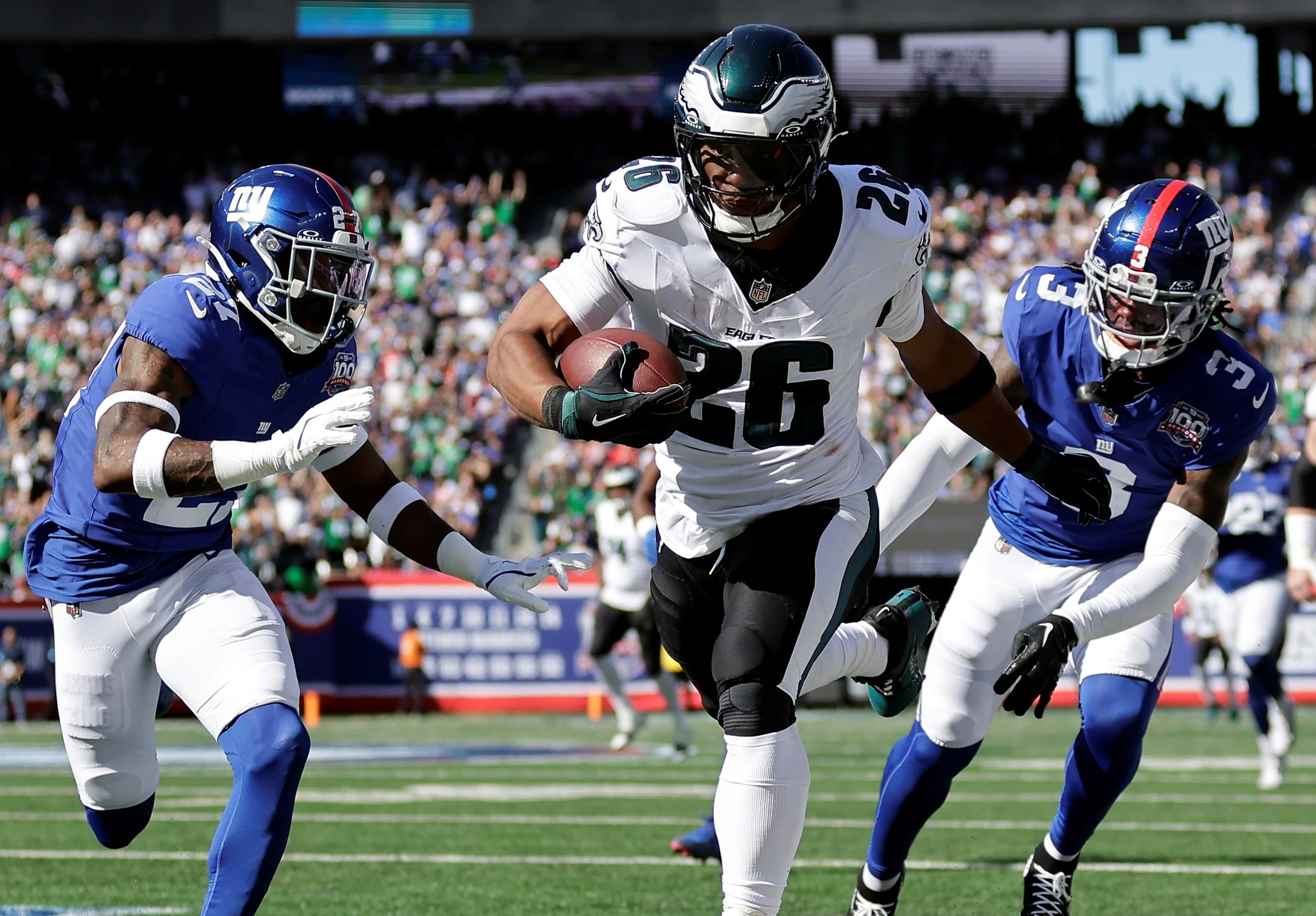
Quick Slant: TNF - Separated by the Width of New Jersey
Mat Irby’s Quick Slant
This wasn’t how the weekend was supposed to go. The Eagles—the reigning champs, winners of 20 of their last 21—were rolling. QB Jalen Hurts reared back and fired along the right sideline, plunking a moon ball into the chest of RB Saquon Barkley downfield. It wasn’t a perfect throw; Barkley had to pull up to meet it, but there was enough space to make the correction. Then, Barkley did the rest, bursting upfield and shedding a tackler for a 47-yard score.
It was 17-3 early in the third quarter. The Eagles were home favorites, and the Broncos had punted five of six possessions, sneaking in a 55-yard field goal between them. For all intents and purposes, it felt like a wrap—not physically, but practically. The two teams just seemed to be on different planes that day. Frankly, that impression hadn’t changed by the time the clock hit zero at the end of the third, even as the Denver drive at hand looked promising. The threat, it seemed, had been extinguished.
Meanwhile, down South, the winless, hapless Saints hosted the Giants—fresh off a shocking upset of the Chargers in the debut of their first-round QB, Jaxson Dart. The G-Men jumped out to a 14-3 lead after two straight successful drives capped by TE Theo Johnson touchdowns. The second was a 15-yard seed that split two defenders, and with it, Dart improved to 11-of-13 for 83 yards, two scores, and no interceptions. He mixed in two scrambles and a designed rush for another 27 yards on the ground.
The results to that point seemed conclusive: the Giants were dramatically improved with the QB change, but the Saints were an easy mark. This wasn’t a contest. As bad as the Giants had looked, the Saints were a rung below even that.
But one thing is certain about the NFL: nothing is.
Before the Broncos took over with 2:38 left in the third, they had amassed just 145 yards. From there, they’d gain 186 more. A gutsy two-point conversion call with 7:36 remaining gave Denver its first lead, and they kept Philadelphia’s well-regarded offense under wraps the rest of the way. Improbably enough, they came back and won.
Down off I-10, after the Giants’ scorching start, they failed to score again. The script flipped completely, and by the end, it was New Orleans that looked like a tier above, erupting for 26 unanswered points and making Big Blue look more like baby blue.
No, nothing is a sure thing in the NFL. Just ask the Packers, who lost to the Browns after torching the Lions. Ask the Rams, who fell to the 49ers’ backup skill core last Thursday. Ask the Bills, who the Pats dropped on Monday. Or the Ravens, who are 1-4.
When we see this kind of point spread—anything north of a touchdown—remember these facts. We’ve had it reinforced enough by now. And this game is more than just a big spread. It’s two teams that feel like they’ve lost something and are cornered: the Eagles, trying to defend the heavy crown and sensing something’s broken; the Giants, whose GM and coaching staff are at DEFCON 1,000,000, trying to save their jobs. And this, like last Thursday or last Monday, is a divisional rivalry—two teams separated by the width of New Jersey, fighting for bragging rights in the Tri-State and for footing in the NFL’s most hallowed division.
This game will never not matter.
Eagles
Implied Team Total: 24.5
Entering Week 6, the Eagles have overachieved. They are at a rate that will net them 3.9 wins over expected (4th), according to Pythagorean expected wins.
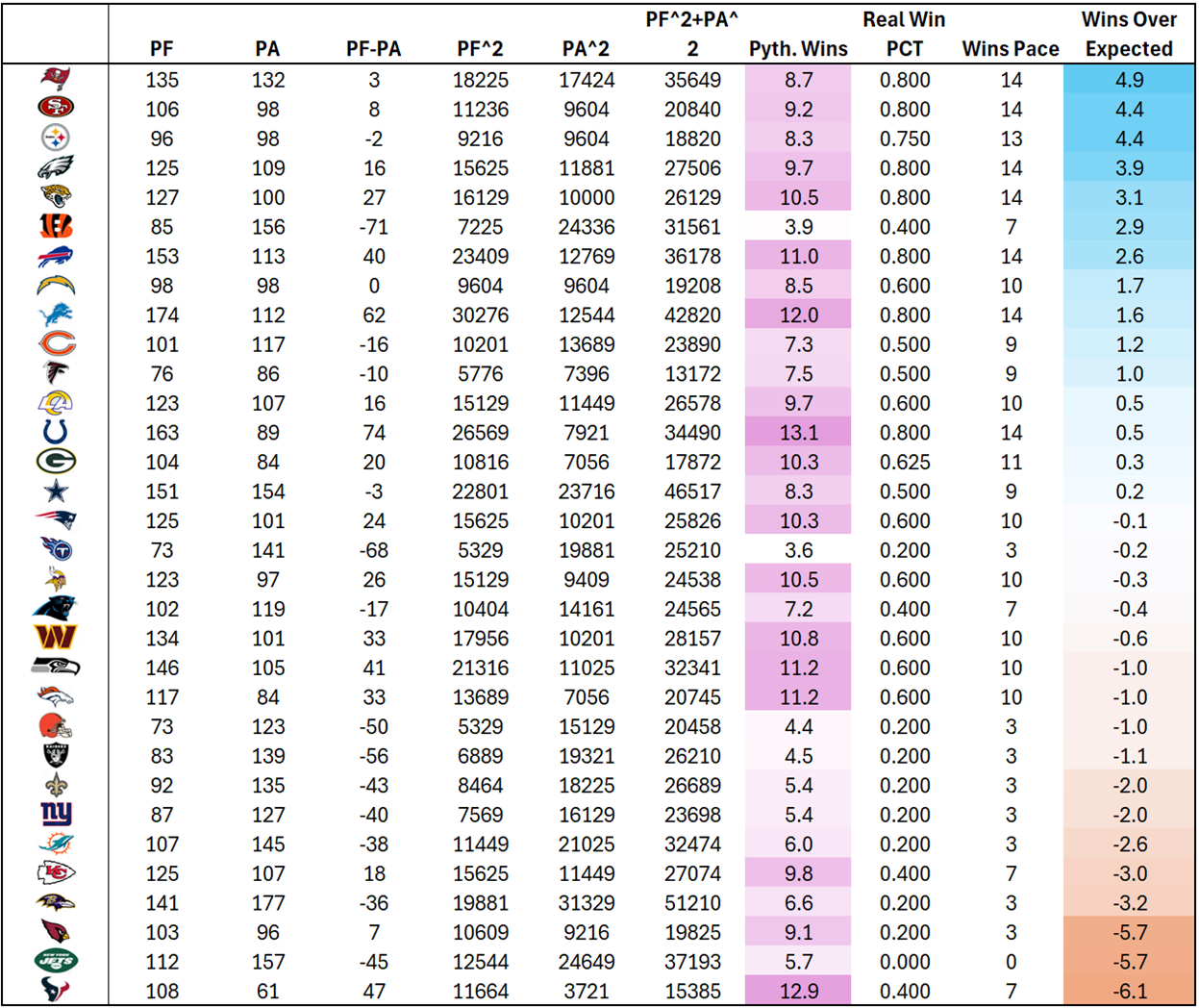
Philadelphia has a reputation for running the ball incessantly. After leading the NFL in run rate a year ago (55%), they entered last week’s game against Denver with the highest rate again (54%), including from a neutral game script (56%). Perhaps it was the grumblings from their star WRs leading up to last week’s game; maybe it was the fans’ wishcasting. Whatever the impetus, the Eagles came out with an entirely different approach Sunday, throwing at a 79% rate from a neutral script (T-2nd).
Before we jump to conclusions without context, it's worth noting that throwing was working for Philly, at least early. They were throwing as they leaped out to the aforementioned 17-3 advantage. However, they also tried to keep the pedal to the metal, and their run rate only increased; while up by two TDs, they threw at an 88% rate.
No, the Eagles weren’t exactly special on the ground, logging a -1.35% offensive rush EPA on Sunday, but on such a short sample (11 attempts), deductions are tough to make. Unmistakably, they’ve been one of the best rushing teams in the NFL over the past 14 months; Barkley led the league with 2,005 rushing yards in 2024, and Hurts finished third among QBs with 650. The Eagles led the NFL in rushing yards and offensive rush EPA.
This year, something has been a little off. Despite their abundance of attempts—32.8 through four weeks (2nd)—they came into last week with only 113.5 yards per game (16th). While their EPA had decreased from what it was a year ago, it had remained a net positive at +0.24% EPA per rush (6th). To date, their pass rate over expected is -5.97%, making them the sixth-most run-prone team in the league against circumstance, and their offensive rush EPA is +0.11%, ranking fifth.
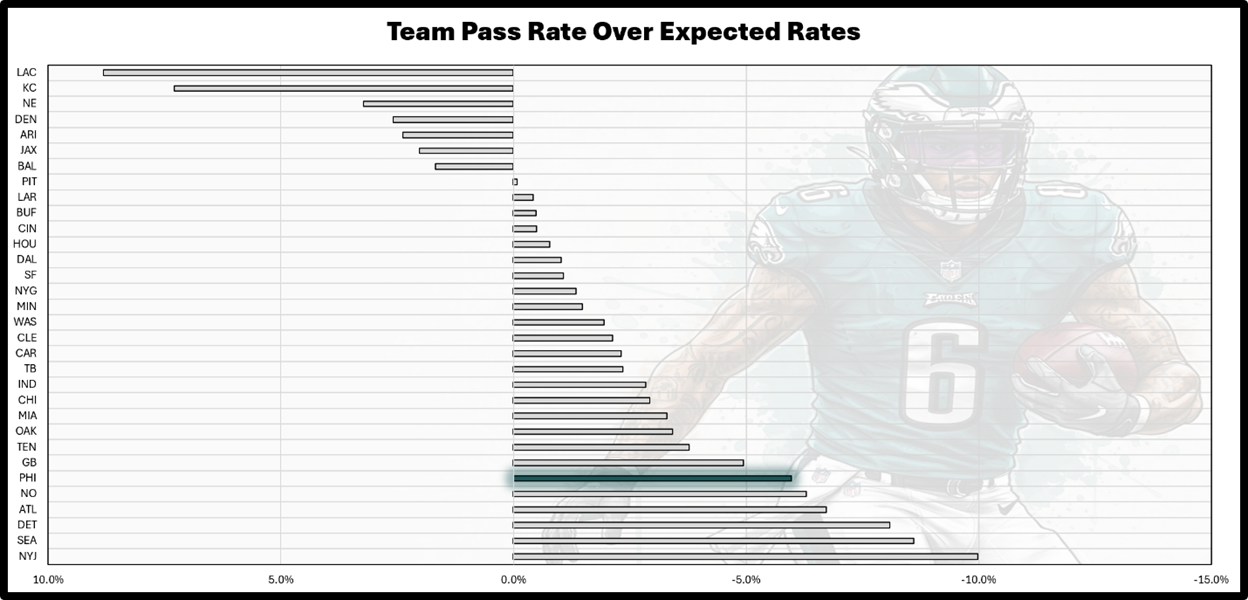
This is purely anecdotal, but the Eagles may feel prompted to adjust their more aggressive throw rate from last week based on the results. Even though there is sufficient reason to believe it wasn’t to blame for the loss, the story can be simply put: the team was 4-0 before, and, after altering their game plan for one game, they are now 4-1. It would be somewhat natural for the Eagles to want to return to what has been working for them, almost without exception, for the past 14 months.
Philadelphia has run 307 offensive plays (23rd). With their imbalance in favor of the run, Hurts has dropped back 175 times (15th).
Obviously, with a player like Hurts, there is a further reduction in attempts from there, as he runs on a significant percentage of his dropbacks; Hurts has scrambled 17 times (T-3rd). All in, Hurts has 139 passing attempts (20th). I mention this to help build the framework for how the Eagles’ offense operates, not because his 17 scrambles should be viewed negatively from a fantasy perspective.
For whatever feels off about the Eagles’ offense so far from the juggernaut they had a year ago, it seems harsh to pin it on Hurts; he is basically the same this year as he was last. In terms of rate stats, he remains essentially the same; however, in terms of volume stats, there is a decrease. I deduce that this is tied to team context.
|
|
PPR/G |
EP/G |
FPOE/G |
Pass Yds/G |
Rush Yds/G |
QB Rating |
|
2024 |
23.2 |
21.5 |
1.7 |
193.5 |
42.0 |
103.7 |
|
2025 |
22.9 |
21.0 |
1.9 |
177.8 |
36.4 |
101.3 |
The dropoff is in efficiency, so Philly is not making the most of its opportunities. Their offensive dropback EPA ranks just 23rd this year. That includes Hurts, but it is tied to the entire breadth of the passing game, including the offensive line and skill core.
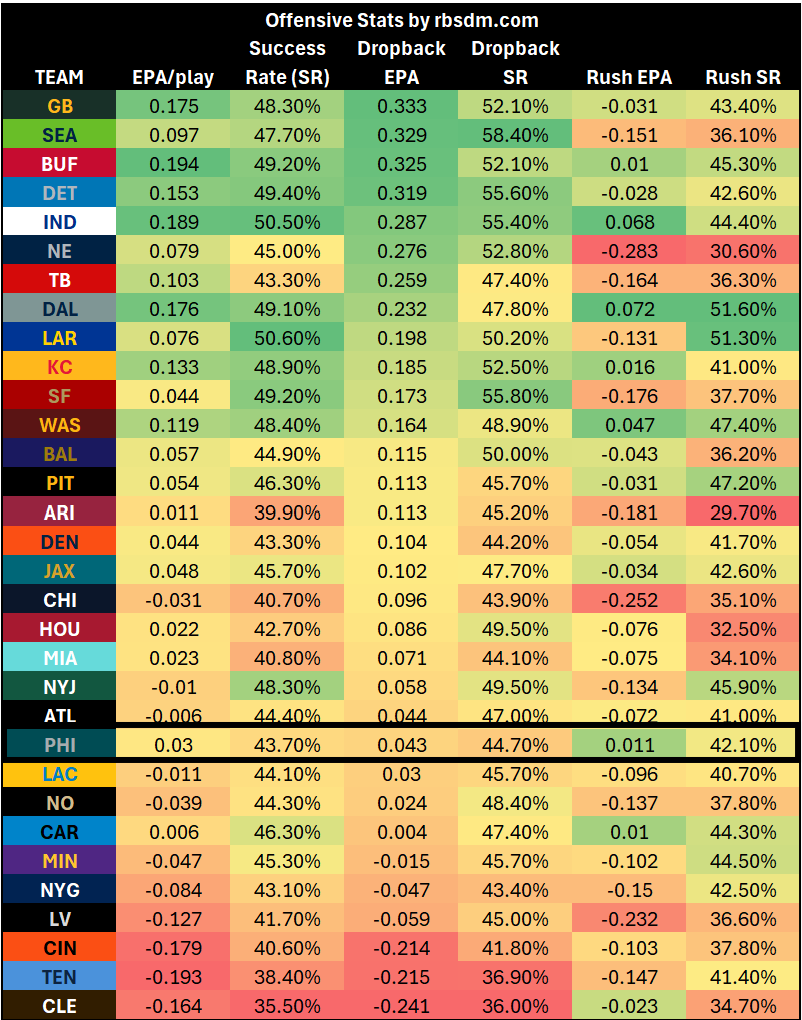
When diagnosing this, my first instinct is to investigate big throws. Strangely, Hurts has been better on throws of 20+ yards this season thus far. Through five games last year, he had a completion percentage over expected (CPOE) of -4.8% on throws of 20 yards or more, whereas this season he has a +6.0% CPOE. He already has eight completions on such attempts, two of which have gone for scores. Last year, through five games, he had yet to complete one. Hurts improved in CPOE over the course of 2024, but not beyond what we’ve seen in 2025, landing on an identical +6.0% CPOE on throws of 20+ yards.
So, where else could the problem lie? The answer may be found in the very WRs who have chirped for more opportunity.
It is no secret that WR A.J. Brown and WR Devonta Smith make up one of the most well-respected duos of WRs in the NFL. Brown had 2.99 yards per route run (YPRR) in 2024, and Smith had 2.11; this year, Brown has 1.14 YPRR, and Smith has 1.58. Brown had 4.5 FPOE/G last year, and Smith had 3.8; this year, Brown has -4.5 FPOE/G, and Smith has 1.1. Last year, Brown had 5.3 yards after catch (YAC), and Smith had 4.3; this year, Brown has 3.1 YAC, and Smith has 3.4.
Put plainly, Brown and Smith are each performing poorly in their efficiency metrics, which is negatively impacting the team's dropback EPA.
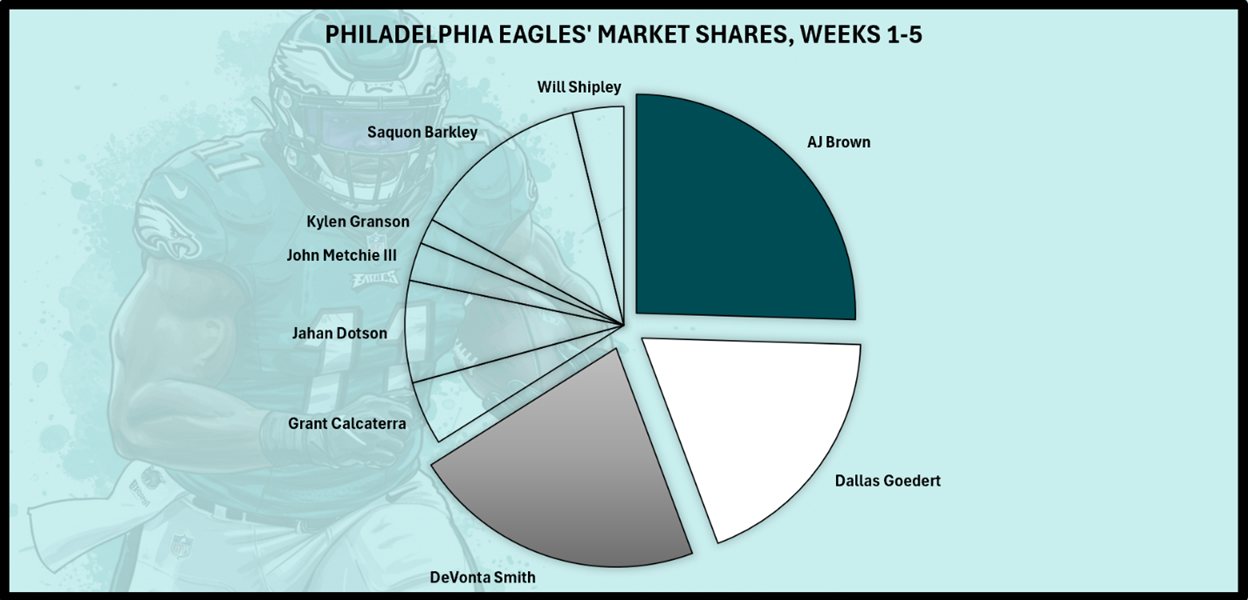
The Eagles maintain a focused passing attack, with essentially three pass catchers of consequence: Brown, Smith, and TE Dallas Goedert. Brown has earned a 27% market share, which leads the team and is still strong, but it is down from last year’s 34%. This would be the lowest market share Brown has had since he was in Tennessee. Smith is at 23%; Goedert is at 20%.
This is actually a tee-tiny uptick for Goedert, as he has never finished with a 20% share. He has finished with a 19% share in four straight seasons, all tied for his best percentage. Goedert ranks fifth in PPR/G (13.1), his best rank since finishing as the TE4 and TE5 in back-to-back seasons in 2020 and 2021. He is enjoying the best efficiency of his career at 3.2 FPOE/G, propped up by his NFL-leading four TDs (T-A. Barner). Even with a higher target share, Goedert still only has 20 targets (T-21st), 15 receptions (T-21st), and 133 yards (23rd). He is the most significant regression candidate based on Yds/TDs regression.
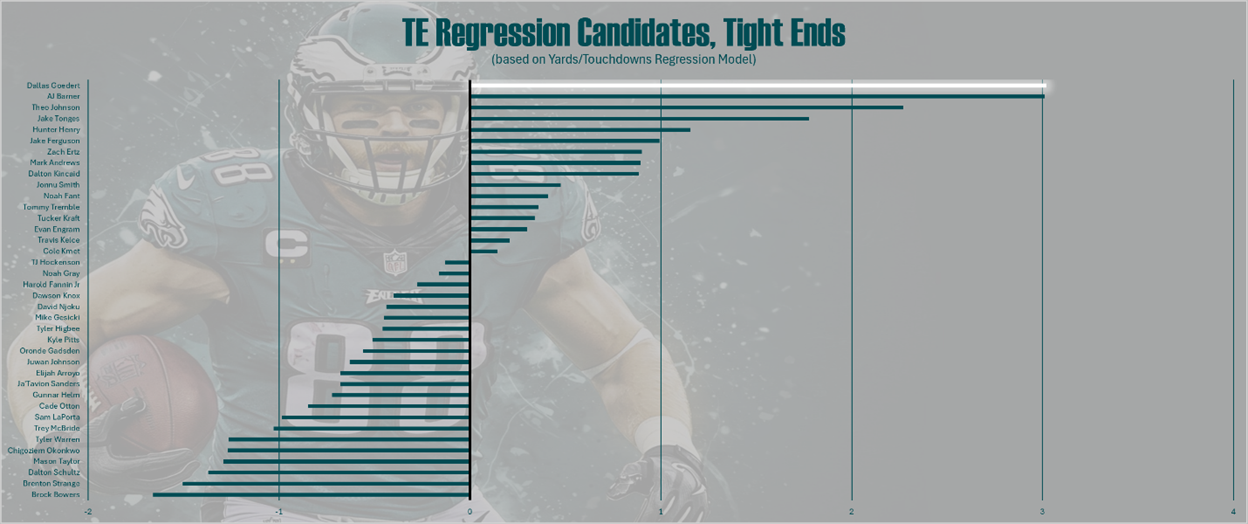
The Giants run the second-highest percentage of man coverage in the league (42.7%) and primarily employ single-high safety looks (58.3%, 6th). Their favorite alignment, by far, is Cover 1 man, which they use at a 37.4% rate (2nd).
Against the types and rates of coverage the Giants use, Brown performs well. According to Fantasy Points’ coverage matchup tool, Brown should expect a bump of about +31.3% (10th) based on coverages alone, and Smith should expect a small bump of about +5.6% (48th). Goedert is wedged in between with a coverage score of +21.9% (5th).
PFF’s matchup model, which is personnel-based, has Brown and Smith with fair matchups. It should be noted that the Giants’ secondary pieces are not graded all that highly; this goes back to the Eagles’ WRs' simple lack of efficiency.
Goedert shows up in PFF’s model with a good matchup. He should perform better when lined up against LBs, but he is expected to see plenty of coverage from a safety, where he shouldn’t fare quite as well.
All of this comes with a massive grain of salt, of course. While things have been bleak thus far for Brown and Smith, each has had a far longer track record of excellent efficiency, so this feels like a slump they’ll crawl out of more than it does a new normal. One possible fly in the ointment may be their offensive line.
Last year, the Eagles ranked sixth in PFF run blocking grade and pass blocking grade; in the aggregate, they were largely viewed as the best offensive line in football. PFF reinforced confidence, despite losing G Mekhi Becton to the Chargers, by placing them first in their preseason offensive line rankings. This has not been the case, in part due to injury, but in part because they simply haven't played as well.
So far this season, the Eagles have allowed a pressure rate over expected (PrROE) of 15.84% (30th). The Giants, who have invested heavily in pass-rushers over the past few years, are expected to enjoy a relatively significant advantage against the Eagles’ pass-blocking unit.
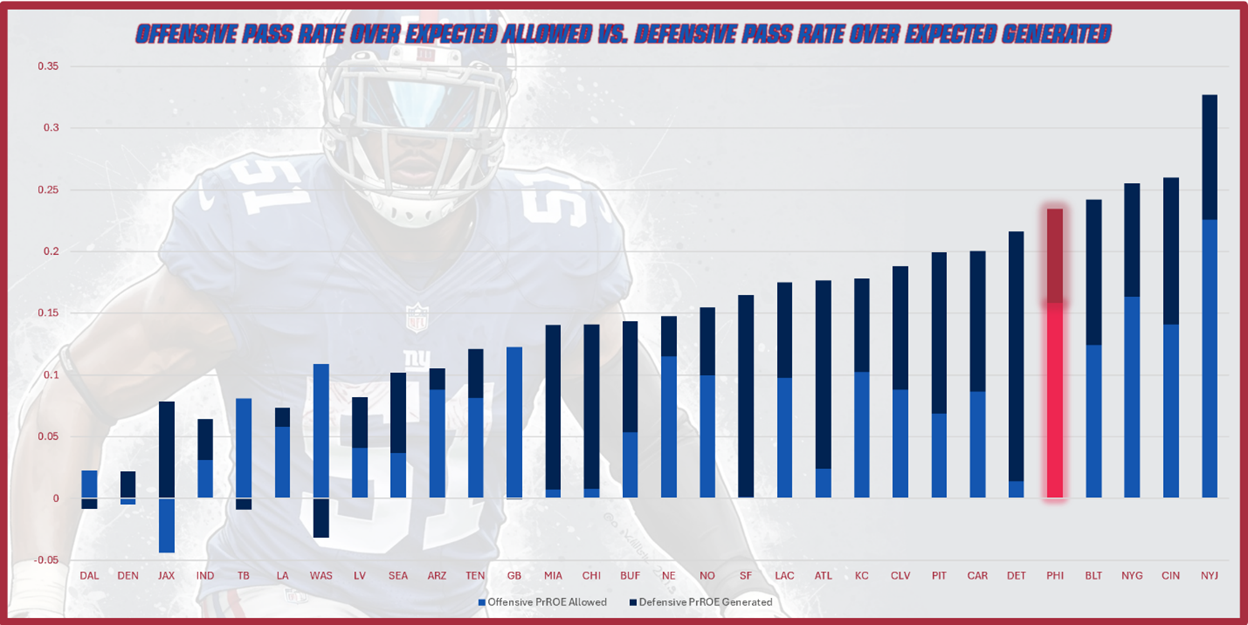
Hurts tends to handle pressure well. His QB rating drops only 12.2 points under pressure, the 10th-most modest drop-off in the league.
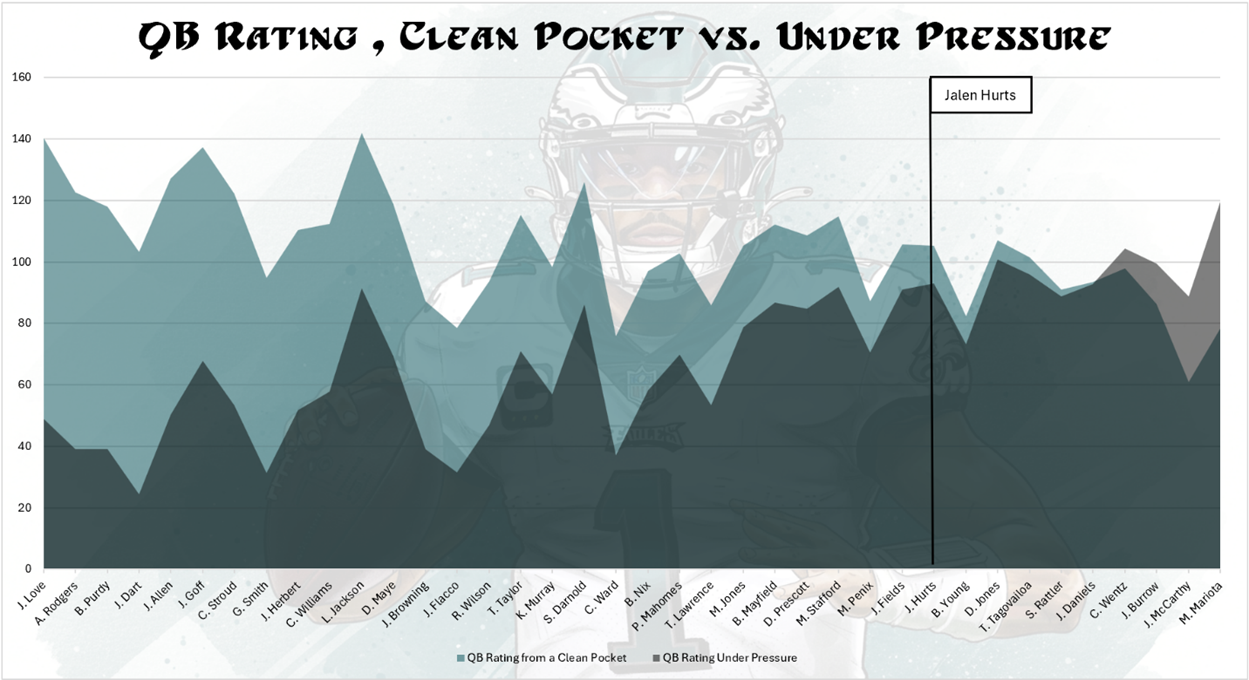
The run-blocking matchup is more neutral than the pass-blocking matchup, with neither side taking a huge advantage.
The Giants are generally ineffective on defense across the board, with a particular weakness in rush defense. New York ranks 30th in rush EPA allowed and 28th in rush success rate allowed. It seems logical that, if the Eagles are inclined to run the football and the Giants are vulnerable to the rush, the Eagles could try to lean on Barkley.
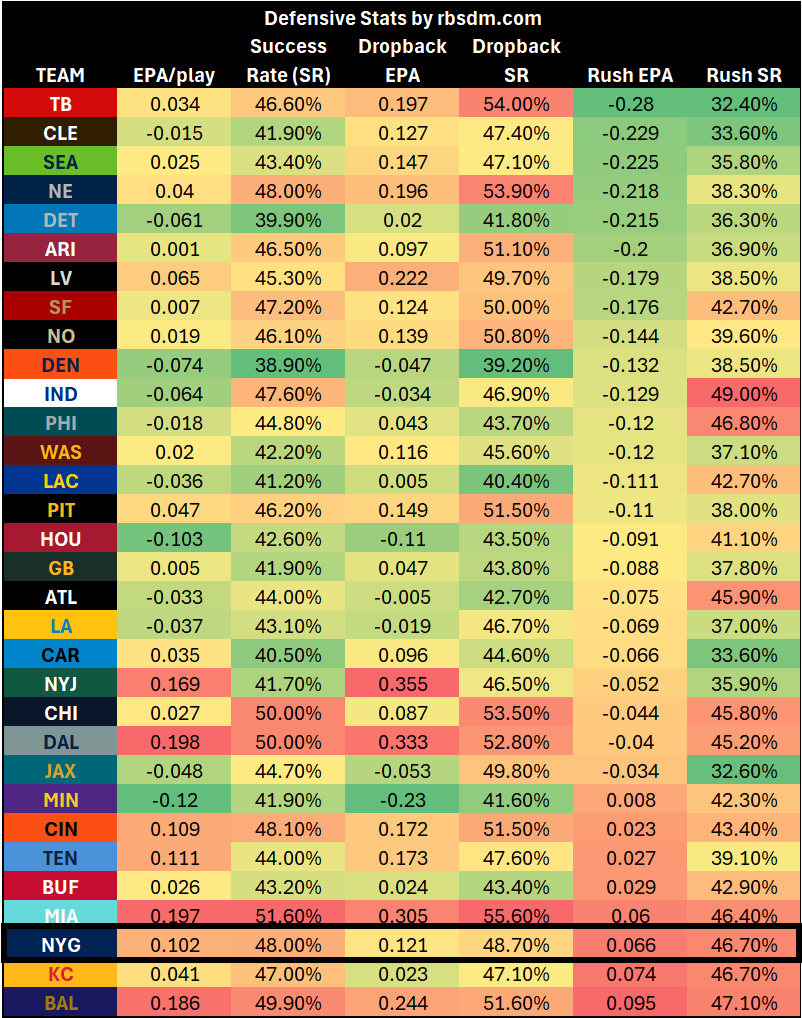
A year after being a fantasy force, Barkley is off to a more tepid start, ranking 11th in PPR/G, 22nd in rushing yards, and 43rd in FPOE/G. One common area for criticism of Barkley is a dramatically reduced YPC (3.2), nearly half of his 2025 output. This, combined with the widespread concern about his workload last year and the implications that might have on his ability to carry over his efficiency, has certainly caused frustration. To add to the anxiety, Barkley has been dealing with a seemingly minor injury this week, although he is expected to play.
Barkley’s EPA per rush is -0.08, putting him in the bottom half of the league. He faces an average of 7.34 box defenders per rush (10th). His percentage of explosive plays has dropped from 8.70% last year to 6.02%. The Eagles rank near the middle (14th) in adjusted yards before contact allowed. He has scored 0.80 TDs per game thus far, compared to 0.94 per game a year ago. He is still not super involved in the passing game.
Each data point contributes to the larger effect of Barkley's reduced fantasy scoring, but efficiency remains the most significant factor of all. Whether that is because he had 490 opportunities last year or not is unknowable; there is certainly room for the narrative to grow. Barkley had better legacy stats a week ago, but again, there weren’t many opportunities with the ball.
If he’s going to get off the schneid, this is a good place to do it. This may be the occasion where a favorable matchup, a wide point spread, and an incentivized playcaller converge to give Barkley the big game we’ve been waiting for.
